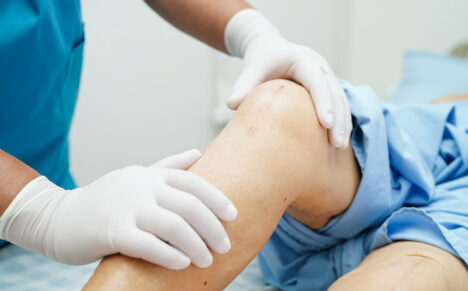Have you been bothered by knee pain? Is the pain becoming bad enough that you are constantly taking over-the-counter medication? Does the pain prevent you from doing things you like to do or need to do?
Knee pain is one of the most common complaints that doctors hear from their patients, and osteoarthritis (which is usually called just “arthritis”) is one of the most common causes of this pain. Knee osteoarthritis can affect anyone, but it is more common as we get older. It can also affect young athletes who put a lot of wear-and-tear on the knee joint. Arthritis can be the cause of chronic (long-term) joint pain, but it can also cause acute, sudden, severe pain.
One of the worst consequences of knee osteoarthritis is that the pain can be debilitating, keeping you from doing the things you love and need to do. If left untreated, arthritis can lead to other related health problems such as a decline in activity, weight gain, and the need to rely on others to help with basic and simple tasks necessary in life.
What Is Knee Osteoarthritis?
Two healthy knees are ideal in order to lead an active lifestyle. Your knees are among the hardest-working joints in your body. Depending on your activity, these joints withstand the force of several times your weight. For instance, whereas swimming puts minimal stress on your knees, running or jumping requires strong, healthy knees.
The knee joint is a hinge joint where the lower end of your thighbone (femur) meets the upper end of your shinbone (tibia). Also within the joint, you’ll find the kneecap (patella), ligaments that are strong bands of tissue that stabilize the bones of the knee, cartilage that offers cushioning between the bones, and synovial fluid that provides for smooth movements without friction.
Knee osteoarthritis can develop after a knee injury, but often the damage occurs over a lifetime – as the activity of daily living, high-impact activities, and repetitive movements all create stress on the joints. This can lead to local inflammation and damage to the different components of the knee joint.
As a joint’s synovial fluid changes, the bony parts of the knee lose protection. Also, as the cartilage wears down – including that of the meniscus (which are two moon-shaped sections of cartilage protecting each knee) – the space in the knee narrows, possibly to the point where bones are rubbing together.
As the bones of the knee become more and more injured and inflamed due to rubbing together, the body tries to heal the damage by creating bone spurs; however, these will cause additional pain and even cause “catching” as you move your knee. As osteoarthritis of the knee progresses, the result is increasing pain and loss of smooth movement.
What Are the Causes of Knee Osteoarthritis?
Prior injury is always a potential cause of knee osteoarthritis, but many things contribute to the development of arthritic knees – some of which can be prevented and some that cannot. For instance, we know that osteoarthritis is more common in women than in men. This type of osteoarthritis frequently runs in families, so there is some genetic component.
Additionally, all knees are not created equally. The specific anatomy of your knee, including the shape of the different components and how well they are aligned, may make you more prone or less prone to osteoarthritis.
However, even if you have a specific predisposition to osteoarthritis, there are certain lifestyle factors that can be changed in order to reduce your likelihood of developing arthritis in your knee joint. Being overweight or obese is one of the biggest causes of knee osteoarthritis and its severity, so losing weight will greatly help.
What you do for a living also makes a difference. If your occupation includes strenuous activity, repetitive movements of the knees, kneeling, climbing, or crawling, then you are more likely to develop knee osteoarthritis. Firefighters, construction workers, and farmers are all at risk of developing arthritis.
Your recreational activities also play a role in the health of your knees. Contact and high-impact sports and activities such as football, basketball, soccer, tennis, jogging, running, and dancing can all contribute to the development of knee osteoarthritis. At the opposite end of the spectrum, inactivity can result in weak leg muscles, which can make your knees more prone to injury and arthritis. Smoking has also been associated with the development of osteoarthritis.
Main Symptoms of Knee Osteoarthritis
The most recognizable symptoms of knee osteoarthritis are pain, stiffness, swelling, and the inability to move your knee as freely as you once did. This can occur in one or both knees. The arthritis pain usually occurs when you are using your knees during activity, and typically is eased when you are resting.
Although your knee may feel stiff when you first get up, movement will generally decrease the pain and stiffness. However, as the day goes on or your activity level increases, the pain will get worse until you rest again.
As the condition continues to progress, you will notice that the knee pain becomes more constant – affecting your ability to do basic activities. You might also find that episodes of pain become more unpredictable. Eventually, dull pain can become an ever-present fact of life, accented by periods of more severe and debilitating pain. That is why you will want to consult with an experienced orthopedic doctor who can help you.
Knee Doctor in Raleigh
If you are experiencing knee pain, or any other type of joint pain or musculoskeletal pain, finding the right orthopedic surgeon to address the issue is key to getting back to the active lifestyle you enjoy. Our friendly medical team is here to answer your questions about knee replacement or any other issues with your bones or joints. Call the offices of Dr. Brett Gilbert today at (919) 788-8797 or you can request an appointment with Dr. Gilbert using our appointment request form, or you can self-schedule your appointment here.




